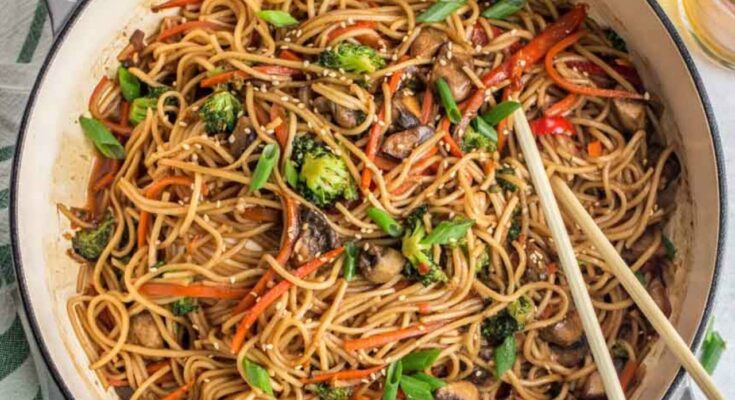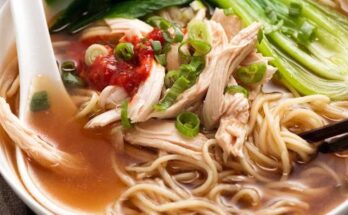Vegetable Lo Mein Recipe: Let’s talk Lo Mein. If you’ve ever ordered Chinese takeout, you’ve probably tried or at least seen Lo Mein on the menu. It’s a popular noodle dish made with stir-fried noodles, a variety of fresh vegetables, and a flavorful sauce that hits all the right notes—savory, slightly sweet, and a bit umami. The term “Lo Mein” comes from the Cantonese “lōu mihn,” which means “tossed noodles.” Unlike Chow Mein, which is typically crispy, Lo Mein is soft, saucy, and incredibly satisfying.
The best part? You don’t need to go out to enjoy this dish. Homemade Vegetable Lo Mein is quick, easy, and healthier than anything you’d get from a takeout box. In just 25–30 minutes, you can whip up a steaming plate of fresh, colorful noodles that hit all the comfort food cravings without the guilt.
Why Make It at Home?
You might wonder, “Why go through the trouble when I can just order it?” Here’s the deal: restaurant-style Lo Mein often comes loaded with extra oil, salt, and MSG—not to mention hidden calories. When you cook it at home, you’re in control. You pick the veggies, balance the sauce to your taste, and adjust the texture just the way you like it.
Also, cooking Lo Mein at home is faster than you think. It’s a one-pan wonder, meaning fewer dishes and minimal cleanup. Plus, if you’ve got leftover veggies in the fridge—broccoli, carrots, bell peppers—they’re perfect for this recipe. Zero food waste, full-on flavor.
Health Benefits of Homemade Lo Mein
When made right, Vegetable Lo Mein isn’t just tasty—it’s also incredibly nutritious. You’re loading your plate with fiber-rich vegetables, plant-based nutrients, and whole or semi-whole wheat noodles (if you choose the healthier versions). Add low-sodium soy sauce or tamari, and you cut back on salt without losing flavor.
Want to make it even better? Use sesame oil for a heart-healthy fat, toss in some tofu for extra protein, and go heavy on antioxidant-packed veggies like spinach, mushrooms, or kale. Homemade Lo Mein supports a balanced diet and fits well into vegetarian, vegan, and even some gluten-free eating plans.
Ingredients You’ll Need
Vegetables for Lo Mein
Here’s where the magic happens. The vegetables give Lo Mein its crunch, color, and flavor. Feel free to swap based on what’s in your fridge, but here’s a great go-to mix:
- Carrots – Julienned or cut into thin strips for color and sweetness
- Bell Peppers – Red, yellow, or green for a vibrant pop
- Snow Peas or Snap Peas – Add a sweet crunch
- Cabbage – Green or purple, sliced thin
- Onions – Sautéed to release sweetness
- Mushrooms – Shiitake, cremini, or button for an umami punch
- Scallions – A must for topping and finishing
You want a balance of textures—soft, crisp, and everything in between. Pro tip: try to cut all your veggies roughly the same size so they cook evenly and look visually appealing.
Noodles – The Foundation
Choosing the right noodles is essential. Lo Mein noodles are usually egg noodles—yellow, chewy, and slightly thicker than spaghetti. If you can’t find them, don’t worry. Here are some great substitutes:
- Egg noodles (fresh or dried) – Best texture
- Ramen noodles – Remove the seasoning packet
- Spaghetti or linguine – Easy to find and decent substitute
- Rice noodles or soba – For gluten-free options
Cook your noodles al dente so they don’t get mushy when tossed with sauce and veggies later.
Sauces and Seasonings
The sauce makes or breaks your Lo Mein. Here’s the flavorful mix:
- Soy Sauce – Go for low-sodium if possible
- Dark Soy Sauce – Adds deeper color and richness
- Oyster Sauce – Optional but adds incredible umami
- Hoisin Sauce – Adds a touch of sweetness
- Sesame Oil – Nutty aroma and taste
- Rice Vinegar or Mirin – A splash for acidity
- Minced Garlic – Always
- Grated Ginger – Brightens the flavor
- Red Chili Flakes or Sriracha – If you like it spicy
Mix these up in a bowl before you start cooking. Taste and adjust to your preference—some like it sweeter, others more savory.
Optional Add-ons
Want to bulk it up? Here’s what you can throw in:
- Tofu (firm, cubed and pan-fried) – For extra protein
- Tempeh – Nutty and dense
- Seitan – If you’re going for a meat-like texture
- Cashews or peanuts – For crunch
- Bean sprouts – Add at the end for freshness
These extras can turn your Lo Mein into a full-blown, protein-packed meal without straying from the vegetarian theme.
Kitchen Tools You’ll Need
Essential Cooking Equipment
You don’t need a commercial kitchen to make Lo Mein, but a few tools help:
- Wok or large non-stick skillet – Best for even heat and stir-frying
- Large pot – For boiling noodles
- Strainer – To quickly rinse noodles
- Mixing bowls – For prepping sauces and tossing noodles
A wok is ideal because of its shape—it distributes heat evenly and allows for fast, high-temperature cooking, which is what stir-frying is all about.
Prep Tools for Cutting and Mixing
Prepping is half the battle. Here’s what you’ll need for a smooth experience:
- Sharp chef’s knife – For chopping veggies
- Cutting board – Preferably wooden or non-slip
- Peeler – For carrots or tougher skins
- Tongs or spatula – For tossing noodles and veggies
Once everything is chopped and ready, cooking takes just minutes. Preparation is the key to stress-free stir-fry success.
Preparing Ingredients Before Cooking
How to Cut Vegetables for Stir-Fry
Speed and consistency matter here. Stir-frying is fast, so your veggies need to cook at the same rate. Slice everything into thin, uniform pieces—think julienned carrots, matchstick bell peppers, and shredded cabbage. Mushrooms should be sliced thin, while onions can be sliced lengthwise for better texture. Keep your greens like scallions or spinach aside to toss in at the very end—they cook in seconds.
This isn’t just about looks—uniform cutting also affects taste and texture. You want every bite of Lo Mein to feel balanced.
Tips for Prepping Noodles
Most noodles cook quickly—5 to 7 minutes tops. Cook them until just tender, not mushy. Immediately rinse under cold water to stop the cooking process and prevent sticking. Toss with a tiny bit of sesame oil to keep them separated while you cook your veggies. This one step can mean the difference between restaurant-quality Lo Mein and a soggy mess.
Organizing Your Cooking Station
Before you turn on the heat, make sure your kitchen station is ready:
- Veggies sliced and sorted
- Noodles cooked and oiled
- Sauce mixed and ready
- Tools within arm’s reach
Once you start stir-frying, things move fast. Having everything prepped in bowls, just like on a cooking show, makes the whole experience smooth and fun.
Step-by-Step Guide to Making Vegetable Lo Mein
Step 1: Cook the Noodles
Boil Lo Mein noodles (or spaghetti as a substitute) in salted water until al dente. Drain, rinse with cold water, and toss with a little sesame oil to prevent sticking.
Step 2: Stir-Fry the Vegetables
Heat 1 tablespoon sesame or vegetable oil in a wok. Add garlic, onions, bell peppers, carrots, cabbage, and snap peas. Stir-fry for 3–4 minutes until tender-crisp.
Step 3: Add Sauces and Combine Everything
Whisk together soy sauce, hoisin sauce, rice vinegar, and a dash of sugar. Add the noodles and sauce to the wok, tossing to coat everything evenly.
Step 4: Final Touches & Plating
Stir in green onions and a sprinkle of toasted sesame seeds. Serve hot with a drizzle of chili oil or extra soy sauce—savory, colorful, and full of umami goodness!
Pro Tips for the Perfect Lo Mein
Best Noodle Texture Tips
Getting that perfect Lo Mein texture is part art, part science. Here’s how to avoid soggy noodles and achieve that chewy, restaurant-quality bite every single time.
- Don’t overcook the noodles—al dente is the goal.
- Rinse under cold water after boiling to stop cooking and remove excess starch.
- Toss with a bit of oil so they don’t clump together.
- Use cold noodles if you have time; they fry better and soak up more flavor.
Also, consider using fresh noodles from an Asian market if available—they usually have better texture and flavor than dry alternatives.
Choosing the Right Wok or Pan
Not everyone has a traditional wok, and that’s okay. But if you do have one—use it. Woks heat up quickly and evenly, making them perfect for stir-frying. If not, use the widest, deepest nonstick skillet you’ve got.
Here’s what to look for:
- Large surface area – More room to toss and stir
- High sides – Prevent food from flying out while mixing
- Even heating – Ensures everything cooks at the same pace
Don’t overcrowd your pan. If you’re making a big batch, cook in two rounds so the veggies stir-fry instead of steaming.
Common Mistakes to Avoid
Even though Lo Mein is simple, there are a few pitfalls that can ruin your dish if you’re not careful. Let’s avoid those:
- Overcooking the noodles – They’ll break apart and turn mushy.
- Skipping the prep – Stir-frying is fast, so prep everything in advance.
- Too much sauce – A little goes a long way. You want flavorful, not soggy noodles.
- Low heat – Stir-frying needs high heat. If your veggies steam instead of sizzle, the texture suffers.
- Not tasting as you go – Balance is key; keep tasting and adjusting.
By keeping these in mind, your Vegetable Lo Mein will not only taste amazing—it’ll look like it came from a high-end Chinese restaurant.
Variations of Vegetable Lo Mein
Spicy Vegetable Lo Mein
If you love a little heat in your meals, turning your classic vegetable Lo Mein into a spicy version is super simple. In fact, the spicy twist adds a layer of depth that balances the sweetness of the hoisin sauce and the umami-rich soy sauces. Here’s how to do it:
- Add chili garlic sauce to your Lo Mein sauce mixture.
- Sprinkle red pepper flakes during stir-frying.
- Drizzle with sriracha or chili oil just before serving.
The beauty of spicing things up is that you can tailor it to your tolerance. Want a gentle kick? A dash of chili oil will do. Want your taste buds to dance? Turn up the heat with a full spoon of sambal oelek.
You can also infuse heat using fresh chili slices like Thai bird’s eye chilies or jalapeños. Cook them with the garlic and ginger at the beginning to spread the spiciness through the oil for an even, lingering heat.
Don’t forget to balance it with sweetness or acidity—spicy Lo Mein pairs beautifully with a bit of lime juice or a tiny drizzle of honey.
Vegan Protein Add-ins (Tofu, Tempeh, etc.)
Vegetable Lo Mein is already a vegan-friendly dish, but if you want to boost the protein content or make it more filling, there are tons of delicious plant-based add-ins to choose from. These are some great choices:
1. Tofu
- Use extra-firm tofu, press out the water, and cube it.
- Pan-fry until crispy before adding to your stir-fry.
- Toss it in some of your Lo Mein sauce for flavor infusion.
2. Tempeh
- Nutty and packed with protein.
- Slice thinly and marinate in soy sauce before stir-frying.
- Adds a chewy texture and nutty depth.
3. Edamame or Chickpeas
- Easy, no-prep-needed options.
- Throw them in during the final stir for protein and texture.
4. Seitan
- A meat-like texture that’s perfect for hearty Lo Mein.
- Stir-fry like meat and add to the noodles.
Adding these ingredients turns your noodle dish from a simple side into a full-on, satisfying meal that will keep you full for hours.
Gluten-Free Version
Going gluten-free doesn’t mean you have to miss out on the savory goodness of Lo Mein. It just means you need to tweak a few ingredients.
Here’s what you need to switch:
- Use gluten-free noodles: Rice noodles, soba (100% buckwheat), or even spiralized veggies like zucchini noodles.
- Swap soy sauce with gluten-free tamari or coconut aminos.
- Skip oyster sauce unless you find a certified gluten-free version.
- Use gluten-free hoisin, or make your own from scratch.
With these swaps, you still get all the flavor and comfort of classic Lo Mein—just without the gluten.
This version is great for people with celiac disease, gluten intolerance, or those simply trying to reduce gluten in their diet. Plus, coconut aminos and tamari are often lower in sodium, which is an added health bonus.
Storing and Reheating Tips
How to Store Lo Mein Properly
If you’ve made a big batch of Vegetable Lo Mein or want to meal prep for the week, proper storage is key to keeping it fresh and flavorful. Here’s what you need to do:
- Let it cool: Always let your Lo Mein cool to room temperature before storing to avoid sogginess and condensation.
- Use airtight containers: Store in BPA-free containers to maintain texture and prevent flavor loss.
- Separate servings: If you’re meal-prepping, divide into individual containers so you can reheat only what you need.
Your Lo Mein will stay fresh in the fridge for 3 to 4 days. After that, the veggies may start to lose their texture, and the noodles can turn mushy.
Want to keep it longer? You can freeze it, but with a few caveats.
Reheating Without Losing Flavor or Texture
The trick to delicious leftovers is in the reheating. Here’s how to do it right:
1. Microwave Method:
- Add a splash of water to the noodles before microwaving.
- Cover loosely with a lid or plate.
- Heat in 30-second intervals, stirring in between.
2. Skillet Method (Best Option):
- Heat a pan over medium heat.
- Add a teaspoon of oil and your noodles.
- Stir-fry for 2–3 minutes until heated through.
The skillet method restores some of the original texture and crispiness that can get lost in the fridge.
Can You Freeze It?
Yes, but it’s not ideal. While the noodles will survive freezing, the veggies may turn soft. If freezing, use firmer veggies like broccoli, bell peppers, or snap peas, and avoid things like spinach or cabbage that become soggy when thawed.
To reheat from frozen, thaw overnight in the fridge, then reheat in a skillet for best results.
Serving Suggestions
What to Serve With Vegetable Lo Mein
Lo Mein can be a complete meal by itself, but if you’re entertaining or just want to pair it with something else, here are a few great options:
- Spring Rolls – Crispy and light, perfect for dipping.
- Hot and Sour Soup – Balances out the savory noodles.
- Steamed Dumplings – A classic Chinese combo.
- Edamame with Sea Salt – Easy and protein-packed side.
- Asian Slaw – Refreshing crunch to offset warm noodles.
Whether you’re serving this for a cozy night in or as part of a full-on Asian feast, Lo Mein holds its own and pairs well with a variety of flavors and textures.
Plating Ideas for Hosting or Meal Prep
Let’s face it—presentation makes food more appealing. Here are some quick ideas:
For Dinner Parties:
- Serve on a large flat platter with chopsticks arranged on the side.
- Garnish with sesame seeds, chili flakes, and fresh scallions.
- Add citrus wedges like lime or lemon for a fresh finish.
For Meal Prep:
- Use glass meal-prep containers for easy reheating.
- Divide noodles and veggies evenly.
- Add protein (tofu or tempeh) on top, separate from noodles to maintain texture.
Lo Mein also looks great in takeout-style boxes for a fun, themed dinner night.
Nutritional Information
Estimated Calories and Macros
Homemade Vegetable Lo Mein is lighter and healthier than takeout, but let’s break down a rough estimate per serving (based on a recipe serving 4):
- Calories: ~350–450 kcal
- Carbohydrates: 50–60g
- Protein: 8–12g (higher with tofu or tempeh)
- Fat: 10–15g
- Fiber: 4–6g
- Sodium: Depends on soy sauce; opt for low-sodium versions
These numbers can shift based on your specific ingredients, portion size, and optional add-ins.
Tips for Making It Healthier
Want to turn your Lo Mein into a clean, low-calorie powerhouse? Here’s how:
- Use whole wheat or rice noodles for more fiber.
- Increase the vegetable-to-noodle ratio (50/50 works great).
- Use low-sodium soy sauce and less oil.
- Add plant-based protein to make it more filling.
- Skip sugary sauces like hoisin or use a homemade, lighter version.
Lo Mein doesn’t have to be a guilty pleasure. With the right tweaks, it’s a satisfying and nutritious meal perfect for any lifestyle.
FAQs about Vegetable Lo Mein Recipe
1. Can I use spaghetti instead of Lo Mein noodles?
Absolutely! While traditional Lo Mein noodles have a unique texture and flavor, spaghetti or linguine work great in a pinch. Just cook them al dente and toss them with a little sesame oil after boiling. They’re sturdy enough to handle stir-frying and soak up the sauce beautifully.
2. How do I keep noodles from sticking together?
The key is to rinse your noodles in cold water immediately after boiling and toss them with a little sesame oil. This prevents clumping and keeps them silky smooth. Also, avoid overcooking the noodles—they should be just tender, not soft or mushy.
3. Can I freeze leftover vegetable Lo Mein?
You can, but it’s not ideal. While the noodles freeze fairly well, the vegetables may lose their texture and turn mushy when reheated. If you do freeze it, use firmer veggies like bell peppers and broccoli. Let it thaw overnight in the fridge and reheat it in a skillet for best results.
4. What sauces can I substitute if I don’t have soy sauce?
No soy sauce? No problem. Here are a few substitutes:
- Tamari – Great gluten-free alternative with a similar flavor.
- Coconut aminos – Slightly sweeter but still salty and umami.
- Liquid aminos – A soy-based, slightly milder option.
Just adjust quantities to taste, since some substitutes are sweeter or saltier than traditional soy sauce.
5. Is Lo Mein the same as Chow Mein?
Not quite. Both are Chinese noodle dishes, but the main difference lies in preparation:
- Lo Mein: Soft noodles that are tossed with sauce and stir-fried veggies.
- Chow Mein: Usually involves crispier noodles, either stir-fried longer or deep-fried for texture.
Think of Lo Mein as saucy and chewy, while Chow Mein is dry, crisp, and a little crunchy.
Conclusion
From prepping your ingredients and mastering the stir-fry process to experimenting with variations like spicy versions or gluten-free swaps, Lo Mein is a dish that grows with your creativity. Plus, it’s one of those recipes that tastes even better the next day, making it ideal for meal prep or leftovers.
Whether you’re vegan, gluten-free, or just looking for a new go-to weeknight dinner, Vegetable Lo Mein checks all the boxes. It’s simple, satisfying, budget-friendly, and most importantly—delicious.
So the next time you’re tempted to order Chinese takeout, skip the delivery app and toss together your own homemade Lo Mein masterpiece. Your taste buds (and your wallet) will thank you.



